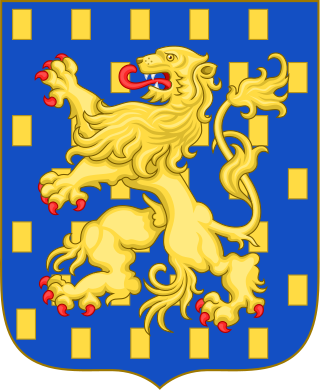
The House of Nassau is a diversified aristocratic dynasty in Europe. It is named after the lordship associated with Nassau Castle, located in present-day Nassau, Rhineland-Palatinate, Germany. The lords of Nassau were originally titled "Count of Nassau", then elevated to the princely class as "Princely Counts". Early on they divided into two main branches: the elder (Walramian) branch, that gave rise to the German king Adolf, and the younger (Ottonian) branch, that gave rise to the Princes of Orange and the monarchs of the Netherlands.
Walram II of Nassau, German: Walram II. von Nassau, was Count of Nassau and is the ancestor of the Walramian branch of the House of Nassau.
Henry II "the Rich" of Nassau, German: Heinrich II. "der Reiche" von Nassau was Count of Nassau. He distinguished himself in particular by his chivalrous and devout spirit. He was charitable and made great donations to the church, so that the monasteries and prayer houses in the area of present-day Nassau experienced the most significant bloom in his time. The greatest favour was the Teutonic Order to enjoy, to which he donated especially for the renunciation of his brother's, upon his entry into the order. Henry participated in the Sixth Crusade. He was the builder of the castles Sonnenberg, Ginsburg and Dillenburg.
Otto I of Nassau, German: Otto I. von Nassau was Count of Nassau and is the ancestor of the Ottonian branch of the House of Nassau.
Walram I of Nassau, German: Walram I. von Nassau, also known as Walram I of Laurenburg, was Count of Nassau and is the oldest Nassau whose ancestorship is absolutely certain. He managed to expand his territory considerably during his reign. He took part in the Third Crusade.

Count John IV of Nassau-Siegen, German: Johann IV. Graf von Nassau-Siegen, official titles: Graf zu Nassau, Vianden und Diez, Herr zu Breda, was since 1442 Count of Nassau-Siegen, of Vianden and of half Diez, and Lord of Breda and of de Lek. He descended from the Ottonian Line of the House of Nassau.

Count John I of Nassau-Siegen, German: Johann I. Graf von Nassau-Siegen, was since 1362 Count of Nassau-Siegen. He descended from the Ottonian Line of the House of Nassau.

Count Otto II of Nassau-Siegen, German: Otto II. Graf von Nassau-Siegen, was since 1343 Count of Nassau-Siegen. He descended from the Ottonian Line of the House of Nassau.

Henry I of Nassau-Siegen, German: Heinrich I. von Nassau-Siegen was Count of Nassau-Siegen, a part of the County of Nassau, and ancestor of the House of Nassau-Siegen. He comes from the Ottonian branch of the House of Nassau.

Count Adolf I of Nassau-Siegen, German: Adolf I. Graf von Nassau-Siegen, was since 1388 Count of Diez, through his first marriage. With his brothers, he succeeded his father in 1416 as Count of Nassau-Siegen, and also inherited the County of Vianden in 1417. He descended from the Ottonian Line of the House of Nassau.

Count John II ʻwith the Helmetʼ of Nassau-Siegen, German: Johann II. ‘mit der Haube’ Graf von Nassau-Siegen, succeeded, with his brothers, his father in 1416 as Count of Nassau-Siegen. With his brothers, he inherited the County of Vianden in 1417, and also inherited half of the County of Diez in 1420. He descended from the Ottonian Line of the House of Nassau.

Countess Joanne of Nassau-Siegen, German: Joanne Gräfin von Nassau-Siegen, official titles: Gräfin zu Nassau, Vianden und Diez, Frau zu Breda, was a countess from the House of Nassau-Siegen, a cadet branch of the Ottonian Line of the House of Nassau, and through marriage Countess of Waldeck.

Count John III ʻthe Youngerʼ of Nassau-Siegen, German: Johann III. ‘der Jüngere’ Graf von Nassau-Siegen, succeeded, with his brothers, his father in 1416 as Count of Nassau-Siegen. With his brothers, he inherited the County of Vianden in 1417, and also inherited half of the County of Diez in 1420. He descended from the Ottonian Line of the House of Nassau.

Countess Mary of Nassau-Siegen, German: Maria Gräfin von Nassau-Siegen, official titles: Gräfin zu Nassau, Vianden und Diez, was a countess from the House of Nassau-Siegen, a cadet branch of the Ottonian Line of the House of Nassau, and through marriage Countess of Holstein-Schauenburg-Pinneberg.
Agnes of Leiningen was a Countess of Nassau by marriage to Otto I, Count of Nassau. She was probably Regent of the County of Nassau for some time for her youngest son after the death of her spouse in 1289/1290.

Count Maurice Frederick of Nassau-Siegen, German: Moritz Friedrich Graf von Nassau-Siegen, official titles: Graf zu Nassau, Katzenelnbogen, Vianden und Diez, Herr zu Beilstein, was a count from the House of Nassau-Siegen, a cadet branch of the Ottonian Line of the House of Nassau. He served as an officer in the Dutch States Army. In the propaganda for the House of Orange, he is regarded as one of the twelve heroes of the House of Nassau who gave their lives in the Eighty Years’ War for the freedom of the Dutch people.

Count William Otto of Nassau-Siegen, German: Wilhelm Otto Graf von Nassau-Siegen, official titles: Graf zu Nassau, Katzenelnbogen, Vianden und Diez, Herr zu Beilstein, was a count from the House of Nassau-Siegen, a cadet branch of the Ottonian Line of the House of Nassau. He served as an officer in the Swedish Army.

Count Christian of Nassau-Siegen, German: Christian Graf von Nassau-Siegen, official titles: Graf zu Nassau, Katzenelnbogen, Vianden und Diez, Herr zu Beilstein, was a count from the House of Nassau-Siegen, a cadet branch of the Ottonian Line of the House of Nassau. He served as an officer in the Hessian Army and the Imperial Army successively.

Countess Mary of Nassau-Siegen, German: Maria Gräfin von Nassau-Siegen, official titles: Gräfin zu Nassau, Vianden und Diez, Frau zu Breda, was a countess from the House of Nassau-Siegen, a cadet branch of the Ottonian Line of the House of Nassau, and through marriage Countess of Nassau-Wiesbaden-Idstein.

Countess Adelaide of Vianden, German: Adelheid Gräfin von Vianden, was a Countess from the House of Vianden, the cadet branch of the House of Sponheim that ruled the County of Vianden, and through marriage Countess of Nassau-Siegen. She acted as regent of the County of Nassau-Siegen for her eldest son in the period 1351–1362.











